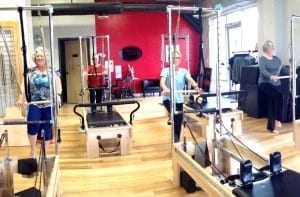Over 600,000 knee replacement operations are performed each year in the U.S., and this number is expected to grow to over 3 million in the next 15 years. In order for patients to get the most out of the procedure, proper recovery is key, and Pilates is an ideal recovery solution! Let’s have a look at all that Pilates has to offer.

1. Build Muscle Memory by Starting Early
Starting Pilates exercises before knee replacement surgery (we call this “PRE-lates!”), allows us to train and build muscle memory in the targeted areas preoperatively. This muscle memory helps speed rehabilitation and brings comfort after the surgery. Getting accustomed to the movements, plus removing any intimidation that might exist (but shouldn’t!), allows you to get a head start on rehab. Even if you aren’t able to start until after surgery, Pilates is still the best rehab program for recovery.
2. Prevent Overcompensation with Proper Posture
When the body experiences pain, it tends to compensate by using and modifying other parts of the body to help ease the suffering. Pilates helps train the body to stop moving as if it is still protecting the area, improves overall posture and facilitates more efficient movement. Altering the body’s compensatory behavior against discomfort will lead to proper movement of the new joint and overall pain relief.
3. Get That Six-Pack!
By targeting exercises that strengthen the core, Pilates helps patients focus on the deep muscles of the trunk (torso) used to stabilize, align, and move from. The stability created offers improved overall fitness and an increased confidence in daily movements, errands, and motion. All Pilates movements revolve around initiating action from a stable, strong core.
4. Rebuild Muscle and Joint Stability for Your Knees
Muscle fibers form along the lines of force they are given – even if the alignment is faulty, the muscles will build in that faulted pattern. Pilates ensures alignment is optimal and correct so that the muscle is strengthened and formed to be of optimal benefit for the new knee joint and all other joints in the body.
5. We Offer Personalized Rehab Pilates Programs
 Patients who have undergone knee replacement surgery are often prescribed different recovery regimes or guidance from their physician. Pilates is easily modified to accommodate individual limitations or surgeon-imposed restrictions to ensure a safe environment while building strength. In addition to altered exercises, Pilates uses pillows, padding, or physioballs to restrict joint motion for safe, fast recovery.
Patients who have undergone knee replacement surgery are often prescribed different recovery regimes or guidance from their physician. Pilates is easily modified to accommodate individual limitations or surgeon-imposed restrictions to ensure a safe environment while building strength. In addition to altered exercises, Pilates uses pillows, padding, or physioballs to restrict joint motion for safe, fast recovery.
6. Full Body Workout
Pilates is used for a wide range of knee ailments and other joint rehabilitation because of its targeted approach to supporting the biomechanics surrounding the joint. However, Pilates is secretly masquerading as a whole body workout! By working on abdominal and hip strength, arm and back strength, and spinal and pelvic work, you are creating a stable platform for the knee joint to perform better and safer.
7. Better Blood Flow
The balanced approach of Pilates, focuses not only on the surgery site but incorporates exercise that builds core strength and two-way stretch to help muscles ‘breathe’ and improve circulation. Increased circulation speeds recovery and develops overall flexibility as the muscles, fibers, and fascia receive sufficient and regular supplies of blood and oxygen.
8. Focus on Quality not Quantity of Exercises in Pilates
Non-weight bearing exercise with controlled breathing and quality of movement is the hallmark of Pilates. Gentle exercise is the best way to increase strength, build up cartilage, and improve circulation. Control, stability, balance, and flexibility are outcomes for all patients!
9. Improved Daily Habits
Most don’t realize they are incorporating bad habits in their daily lives, such as poor posture alignment or movement, but we all do it! Incorporating Pilates into a rehabilitation program not only encourages recovery and mobility but also creates a stronger and more stable self. Strength and stability leads to a more confident way of life, one that is pain-free and stands tall!
10. Benefits of a Home-based Recovery
Once patients have built up their strength base and improved range of motion of the knee, some Pilates exercises can be done safely at home. The relative ease of practicing rehab exercises at home allows patients to build confidence of their capabilities and also increase the convenience of rehab to help accelerate improvement.
If you, or someone you care about, is preparing for an upcoming knee or joint replacement surgery, contact us! We would be delighted to map out a program that ensures faster rehabilitation and improved overall fitness.

